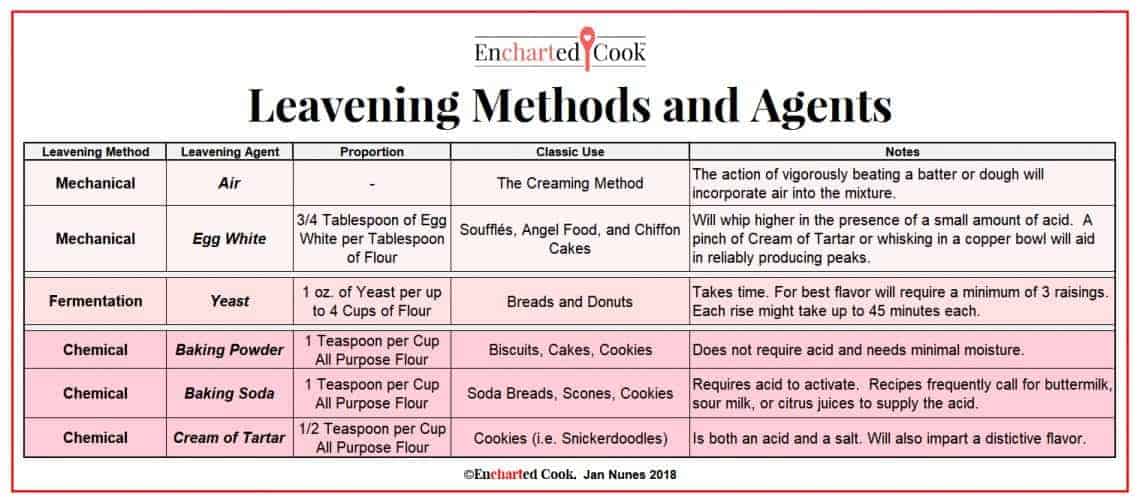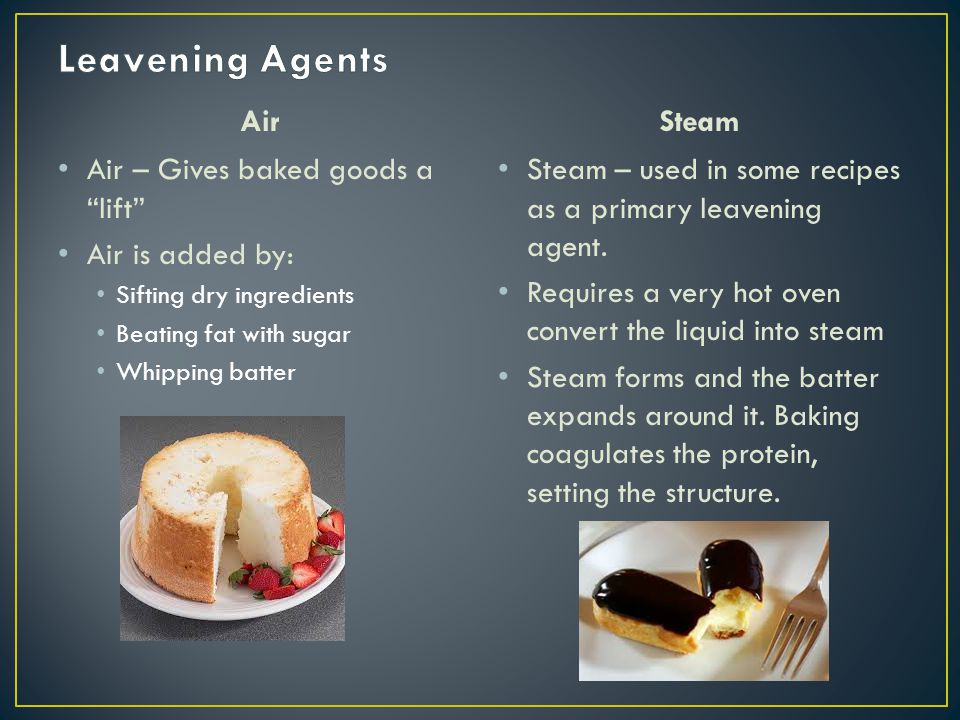
Baking ammonia has a strong smell and flavor therefore it is typically used in cookies and baked goods that are small in size so that the taste and odor is less strong. So what are the leavening agents.

Such agents include air steam yeast baking powder and baking soda.
List of leavening agents in baking. Recipes that are made with baking soda also have an acid on the ingredient list vinegar lemon juice buttermilk yogurt sour cream etc. As the carbon dioxide forms it produces bubbles in your baked goods or unbaked goods which rise. Below are leavening agents and products found in a variety of foods that must be used up or removed by the Feast of Unleavened Bread along with a list of products often confused as leavening.
Leavening Agents and Products please note that this is not an all encompassing list Yeast. This in turn varies according to what youre baking. But the simplest way to think of it is that the leavening agent produces the gas and the gas causes the dough or batter to rise.
There are three main types of leavening agents. Biological chemical and steam. There are many different leavening agents available to the baker.
Include active dry yeast sourdough starter baking soda sodium bicarbonate baking powder baking soda calcium phosphate and sodium aluminum sulfate potash potassium bicarbonate or pearl ash and bakers. The most common leavening agents are yeast Sodium Bicarbonate baking soda and Baking powder. If thats where you are comfortable and dont feel a conviction to do anything more than that then I dont judge you.
So what are the leavening agents. Baking soda and baking powder are the two most commonly used chemical leaveners. Baking soda or sodium bicarbonate is a naturally alkaline product derived from ore most of which is mined in the Green River Basin in Wyoming.
Chemical leavening agents. Baking soda and baking powder Baking soda or bicarbonate of soda decomposes to form carbon dioxide that produces leavening. Baking ammonia is use to leaven cookies such as gingerbread cookies.
Bakers ammonia may also be called bicarbonate of ammonia or ammonia carbonate. Baking ammonia has a strong smell and flavor therefore it is typically used in cookies and baked goods that are small in size so that the taste and odor is less strong. Baking powder is a mixture of leavening agents baking soda and acid salts and inert ingredients like corn starch that react in the presence of moisture and heat to release CO 2.
The use of baking powders helps in achieving a balanced leavening system without the use of mathematics. The bakers most common leavening gas source has been sodium bicarbonate also known as baking soda or just soda. It is slightly alkaline having a pH above 70.
When added to a dough or batter the acid in the flour reacts with the baking soda to release carbon dioxide gas. The more gas produced the more leavening or aeration in the product. A baking powder consists of a base and an acidic part this is the leavening agent.
The base is often sodium bicarbonate E500. The leavening agents are responsible for creating reactions subject to the presence of water heat or acids in the formulation. Recipes that use baking soda for leavening always have an acid somewhere.
It might be obvious such as vinegar in muffins lemon juice sour milk or buttermilk. The acid might be hidden- for example honey and molasses are acidic. This led me to ponder about certain ingredients that are the key leavening agents used in baked goods.
Baking soda baking powder and cream of tartar. The first thing you should understand about baking soda and baking powder is that they are NOT the same thing. Yes baking soda is IN baking powder but they are not interchangeable items.
BICARBONATE OF SODA Baking Soda also called Sodium Bicarbonate BAKING POWDER Contains Baking Soda SOURDOUGH A naturally fermenting yeast batter or liquid SOME OF THE FOODS WHICH CAN CONTAIN ANY OR ALL OF THE LEAVENING AGENTS LISTED ABOVE ARE. Leavening agent substance causing expansion of doughs and batters by the release of gases within such mixtures producing baked products with porous structure. Such agents include air steam yeast baking powder and baking soda.
Leavening of baked foods with air is achieved by vigorous mixing that incorporates air bubbles producing foam. Types of leavening agent Chemical baking powder sodium bicarbonate ammonium bicarbonate by releasing carbon dioxide gas Biological yeast by fermentation Mechanical beating whisking by means of. Chemical Leavening Agents Baking Soda.
Baking soda or Sodium Bicarbonate is a commonly used agent in baking goods. To be used when the recipe involves an acid like lemon juice vinegar yogurt buttermilk or apple cider to cause the reaction. This when combined will begin to.
Baking powder is a chemical leavening agent that is the source of carbon dioxide used in baked goods to provide an airy texture. Raising agents that are used in the kitchen can be classified into the following categories. 2 Chemical Baking powder baking soda baking ammonia.